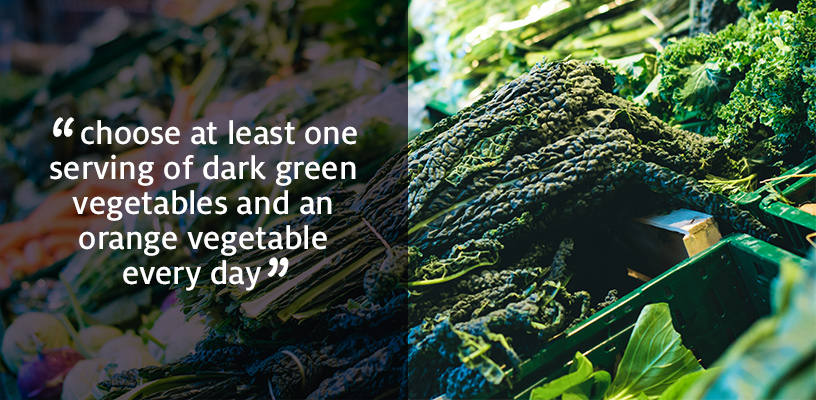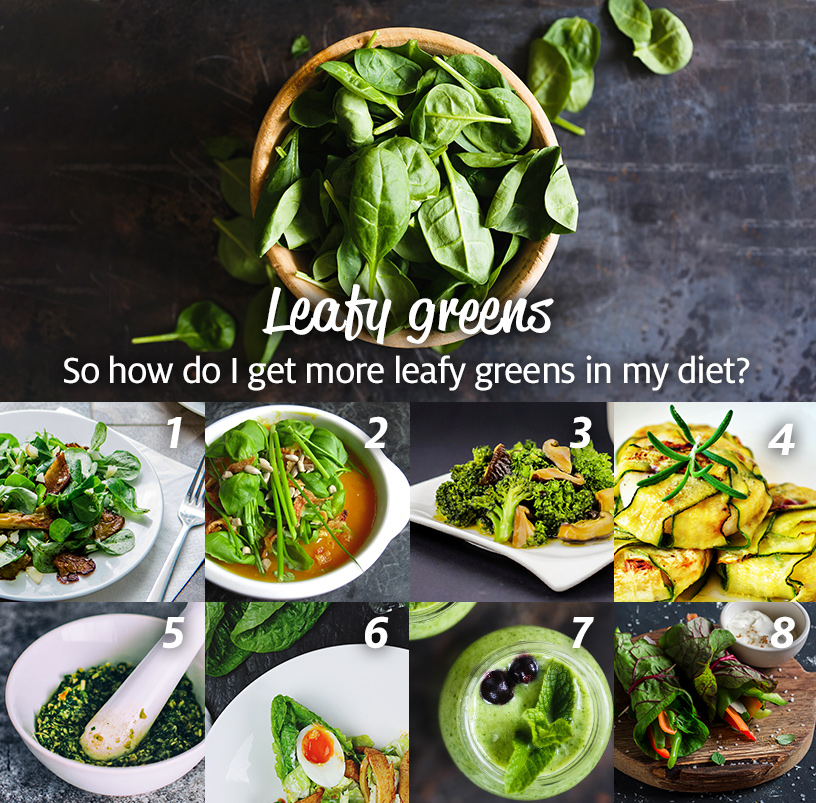When it comes to supporting and maintaining good health, it is hard to discredit the immense value of a diet abundant in vegetables. Vegetables are so beneficial that they are now the most promoted food category in the Canada Food Guide, a position once held by grains and cereal products, with the highest number of daily food servings for all ages and genders recommended to come from produce. And within that guideline comes a further suggestion to ensure that we all choose at least one serving of dark green vegetables and an orange vegetable every day.
And yet, a study by the Canadian Community Health Survey in 2004 reports that as a nation we are falling far short of these goals. Only 26% of Canadians met the daily recommendation for vegetable intake and only 21% of us consistently consume a green vegetable on a daily basis!
Why do green, leafy vegetables matter so much?
Part of the glory of greens comes directly from the colour of the vegetable itself. Chlorophyll is produced by plants from carbon dioxide and sunlight (and a little chemistry) and provides the characteristic green pigment to all leaves. Chlorophyll has been isolated and studied in a laboratory environment to clarify its role in human health. Chlorophyll is the predominant antioxidant in nature and has the ability to bind various cancer-causing molecules to deactivate them and escort them from the body.
Every molecule of chlorophyll contains magnesium at its core, so visually it becomes very easy for us to identify foods that can provide this essential mineral. Magnesium is a common deficiency amongst Canadians – likely due in part to our national lack of green veggie intake! Magnesium has a wide range of effects in the body, including helping to us to manage stress by supporting muscle relaxation and adrenal health.
But chlorophyll is only one component of many in green vegetables. Also present are antioxidant carotenoids, flavonoids, phenols, and a range of vitamins and minerals.
All I can think of is lettuce, spinach, and kale… any other greens I can try?
Yes!! We have preconceived notions of which vegetables, and which parts of vegetables to eat, based on how we were raised and the societal status quo around food. If you want to diversify from raw lettuce or spinach, and cooked broccoli or kale, try picking up the following the next time you’re at the grocery store or farmer’s market: collard greens, water cress, cabbage, frisee, and endive, and the often composted green tops of beets, carrots (not just for rabbits!), and turnips. Herbs count too but are hard to consume in great quantities and are more of an adjunct to other green dishes. For added inspiration, take a stroll through a local ethnic grocery store if you have one nearby. Don’t be shy to ask for serving suggestions (otherwise this is when an internet search can really shine!).
So how do I get more leafy greens in my diet?
- Salads. It may seem too obvious a solution but a simple side salad of lettuce (romaine, green, red, boston), arugula, spinach, baby kale or other leafy greens to accompany a meal is a good habit to develop. Salad as a main course with a variety of other veg and good quality protein is wonderful in the summer months.
- Soups and stews. A handful of baby kale, spinach, arugula, or watercress stirred into a bowl of soup makes for a quick and easy meal with added nutrition. Busy at the office? A can of soup works just fine in a pinch!
- Wilted or stir-fried. Chard, collards, and most salad or veggie top greens are amazing when sautéed gently in a little high quality oil with garlic, salt, and pepper. Squeeze some fresh lemon over top before serving and you’ll wonder why you ever had trouble getting your daily dose of greens! Thinner greens like arugula and spinach are ready in no time, but those with tougher fibres like collards and kale require a little more cooking.
- Roasted. Ok, not all greens suit this method of preparation but green veggies with a little more structure, such as kale, broccoli (with leaves!), Brussels sprouts (with outer leaves!), green beans, zucchini and asparagus really shine when drizzled with a little olive oil and roasted in the oven.
- Blend into salad dressings and sauces. Herbed vinaigrettes and pesto with watercress, blanched carrot/turnip/beet greens, and/or arugula blended right in are wonderful ways to add a nutritional punch to your foods.
- Scrambled eggs, breakfast burritos, and quiches. Easy breezy – add eggs to your wilted veggies (see #3) for a complete meal in record time.
- Smoothies (or juices). Toss a handful of greens (arugula, parsley, basil, cilantro, mint, spinach) or a scoop of Botanica Organic Greens for added convenience into the blender with fresh or frozen fruit, an avocado, protein powder, and healthy oils (flax, fish, coconut) for a tasty meal on the go…and not just breakfast either.
- In lieu of wrap, chip, or cracker. Collard greens are nature’s answer to the sandwich wrap, while Belgian endive is a perfect scoop for dips and tuna or chicken salad.
Enjoy your greens!!
References:
http://www.hc-sc.gc.ca/fn-an/food-guide-aliment/basics-base/quantit-eng.php
http://www.hc-sc.gc.ca/fn-an/food-guide-aliment/choose-choix/fruit/index-eng.php
Black JL, J-M Billette. Do Canadians meet Canada’s Food Guide’s recommendations for fruits and vegetables? Appl. Physiol. Nutr. Metab. NRC Reseach Press.


